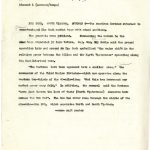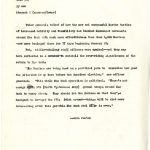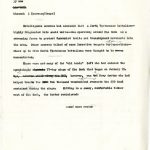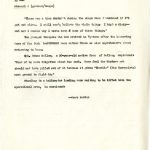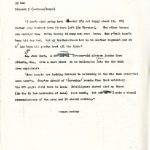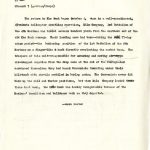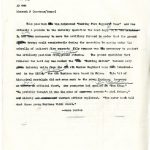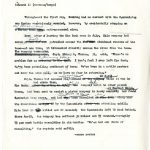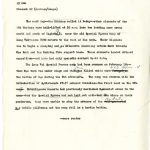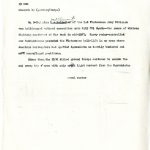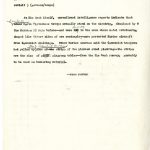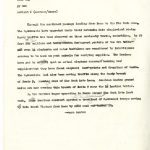1968, October 9, “Khe Sanh Combat Base”
zczc sag
yy nnm K/S.
khesanh 1(normass/deepe)
KHE SANH, SOUTH VIETNAM, OCTOBER 9–The American Marines returned to the once-besieged Khe Sahn combat base with mixed emotions.
The generals were jubilant. Commanding the return to the absx base abandoned 92 days before, Maj. Gen. RayRaymond Davis said the ground operation into and around it Khe Sanh symbolized “the major shift in the relative power between the Allies and the North Vietnamese” operating along the demilitarized zone.
“The Marines have been squeezed into a smaller area,” said the commander of the Third Marine Division–whih now operates along the western two-thirds of the 40-mile-line. “And this has increased our combat power many fold.” IN addition, the general said the Marines “have just thrown the last of their (North Vietnamese) elements back across the Ben Hai“. The Ben Hai river runs through the middle of the six-mile-wide DMZ, which separates North and South Vietnam.
==more rejt reuter
zczc ss
zczc sag
yy nnm
khesanh 2 (normass/deepe)
Other generals talked of how the new and successful Marine tactics of increased mobility and flexibility had blocked Communist movements around Khe Sanh with much more effectiveness than when 6,000 Marines were onced besieged tehre for 77 days beginning Jaunuary 21.
But, middle-echelong staff officers were cynical–and they may have reflected in a nutshel th nutshell the over-riding significance of the return to Khe Sanh.
“The Marines are being used as a political pawn to dramatize how good the situation is up here before the AMerican election,” one officer grumbled. “This whole Khe Sanh operation is political. “There’s not enough North NVA (North Vietnamese Army) ground troops around Khe Sanh to worry about. They should let the Marines do what they’re designed to do–get the NVA. Stick around–things will be alot more interesting after this gee-whiz Khe Sanh deal if ov is over.”
==more reuter
zczc sag
yy nnm
khe sanh
khesanh 3 (normass/deepe)
Intelligence sources had assessed that a North Vietnamese battalion–highly fragmented into small units–was operating around Khe Sanh as a screening force to protect Communist trails and transhipment movements into the area. Other sources talked of more lucrative targets for Marine operations–where up to five North Vietnamese battalions were thought to be masse concentrated.
There were not many of the “old hands” left who had endured the agonizingly cleotric 77-day siege of Khe Sanh that began on January 21. One, however still along the DMZ, however, was thea Navy doctor who had helped treate the 2000 two thousand wounded Marines and evacuate the 250 dead sustained during the siege. Sitting in a sunny, comfortable bunker west of Khe Sanh, the doctor reminisced:
==mof more reuter
zczc sag
yy nnm
khesanh 4 (normass/deepe)
“There was a time durin t during the siege when I wondered if I’d get out alive. I still can’t believe the whole thing. I kept a diary–and now I wonder why I wrote down f some of those things.”
The younger troopers who had arrived in Vietnam after the harrowing days of Khe Sanh had passed were either blase or else apprehensive about returning to base.
Cpl. Bruce Miller, a 20-year-old native from Dallas, explained: “Most of us have forgotten about Khe Sanh. Many feel the Marines syo should not have pulled out of it because it gives ‘Charlie’ (the Communists) more ground to fight in.”
Standing in a helicopter landing zone waiting to be lifted into the operational area, he continued:
==more reuter
zczc sag
yy nnm
khesanh 5 (normass/deepe)
“I don’t mind going into it–but I’m not happy about it. I’d rather stay back–I have 52 days left (in Vietnam). The other troops are worried too. We’re losing too many men over here. Our y unit hasn’t been hit too bad, but my brother-in-aw law is in another regiment and it h has been hit pretty hard all the time.”
1Lt. Jack Hart, a 26-tear-ol 26-year-old platoon leader from Atlanta, Ga., with a unit about to be helicopterED into the Khe Sanh area explained:
“Some people are looking forward to returning to the Khe Sanh area–but some aren’t. They’re afraid of ‘incoming’ rounds from that artillery the NVA might still have in Laos. Intelligence showed alot up there (in the Co Rac mountains of Laos) last month, but our re v I made a visual reconnaissance of the area and it showed nothing.”
==more reuter
zczc sag
yy nnm
khesanh 9 6 (normass/deepe)
Even senior commanders are mystified as to what has happened to the potent 130 mm millimeter field artillery the Communist has buried in the sides of the Co Rac mountsMOUNTAINS in Laos. Some officers believe the artillery pieces are now being shuttled around to unknown gunpostitions in Laos–but others fear the bu tubes are being towed further south, even into South Vietnam proper, where they would not be immune from Allied ground forces. The last time the American officers know that the Communist artillery in Laos has been fired was July 6–on the day Marine thethe last of the 6,000 Marines “de-activated” or abandoned the Khe Sanh base.
==more reuter
zczc sag
yy nnm
khesanh 7 (normass/deepe)
The return to Khe Sanh began October 4, when in a well-coordinated, 45-minute helicopter shuttling operation, Kilo Company, 3rd Battalion of the 4th Marines was landed several hundred yards from the northern end of the old Khe Sanh runway. Their landing zone had been–during the sieg 77-day siege period–the bunkering position of the 1st Battalion of the 9th Marines on a finger-like x knob directly overlooking the combat base. The troopers of this unit–responsible for securing and moving air-droppe air-dropped supplies from the drop zone at the end of th erunway–had convinced themselves they had heard Communists tunneling under their hill-knob with shovels swaddled in burlap sacks. The Communists never did blow up the hill and Marine positions, but when Kilo Company landed their there last week, the know knob was hardly recognizable because of the Marines’ demolition and bulldozer work as they departed.
==more reuter
zczc sag
yy nnm
khesanh 8 (normass/deepe)
Kilo Company had also been the last company out of the Khe Sanh area during the evacuation last July in July. Guny Sergrat Sergeant Raymond Hatchell, 38, of Florence, S.C. remembered well theirKilo’s departure from Hill 471, 500 yards away from the garbage dump road of the Khe Sanh combat base.
“Just as we were leaving, I was awfully busy,” the senior sergeant in the company explained. “About 5 p.m. we ot a radio message that we were to hold on Hill 471 that night. Then the helicopters came in and said that we’d have to evacuate that HillHill on five minutes notiv notice. When the NVA saw all the activity that we were getting ready to move out, they started mortaring us. They threw in 40 or 50 mortars on us and I had to mov ethe company 400 meters away from there so the helicopters could come in. Then we were takenxmtoxmthemm flown out. That’s how we left Khe Sanh.”
Last week, though, Kilo company landed unopposed on the position–w “With not one shot being fired” — and was followed by Marine engineers, who with “back-hoe” machines dug out circular indentations for the Marine and Vietnamese artillery that followed and trenchlines fom the andbunke bunkering positions for the Marine troopers.
==more reuter
zczc sag
yy nnm
khesanh 9 (normass/deepe)
This position has was codenamed “Nanking Fire Supportx Base” and was actually a prelude to the infantry operation the next dayP, with the artiller It had beenwas necessary to move the artillery forward in order that the ground troo s troops would consistently during the operation be moving under the umbrella of indirect fire support; Kilo company was tox necessary to protect the artillery position from Communist ground attacks. The ground operation that followed the next day was called the “Nak “Nanking Action” because only groun infantry units from the 49t 4th Marine Regiment were info involved–and in the 1920s AND 30S,, the 4th Marines were based in China. This bit of historical nostalgia did not mean much to the young Marines, however; on charts anOne official chart, one youngster had spelled itThe operation “Nan King.” “He probably thought it ws the name of soms one someone’s girlfriend,” and elderly ser warran off warrant officer explained. “You never cann tell what these young Marines think about.”
==more reuter
zczc sag
yy nnm
kehsanh 10 (normass/deepe)
Through-out the first day, Nanking had no contact with the Communists; one Marine was|seriously wounded, however, by accidentally stepping on a Marine land mine.An American anti-personnel mine.
Even after e leaving the Khe Sanh area in July Kilo company had roved around and oonAND patrolled around the Khe Sanh abandoned remains of the base–at one time, it bivouacked directly across the river from the base. Them coompany commander,The company commander, Capt. Sidney E. Thomas, 31, said, “There’s no problem for us returing to Khe Sanh.Returning Here. I don’t feel I ever left Khe Sanh. We’ve been patrolling southeast of here. We’ve been in a mobile posture and know the area well, so we have no fear in returning.”
Capt. Thomas had assumed his Company command of the companyin April while it was in Khe Sanh; after departing in July,and since then, Kilo company had moved to other patrol bases, had been sent to assist a sister company in heavy contact at Foxtrot Ridge, had found Communist base camps, and had onceon June 18th been assaulted on June 18th along hison its frontlines on June 18th by the Communists attac ata attacking uphill. Kilo lost 20 and killed and 20 wounded; the Communists left 70 dead behind. Since April, the company has suffered 30 killed and 75 wounded.–roughly 75 per cent battle casualties in six months. “We’ve had our share of casualties,” the captain said softly.
==more reuter
zczc sag
yy nnm
khesanh 11 (normass/deepe)
One trooper with artillery unit at Nanking had also been in Khe Sanh in Jube June–after the siege was lifted on April 1, but before it was evacuated on July 6. He was Sgt. Alan Bollings, 21, of Birminghal Birmingha Birmingham, Ala, a section chief for the 105 millimeter howi howitzers.
“I was glad to come bac up back up here again,” he said. “I like it up here. There’s a lot better weather, scenery and gunpositions up here. I was a little surprised in a way. I thought the airstrip had been taken up–but it still looks the same as aw always.
“When I was here in June we were still taking a lot of incoming. I remember we were positioned on the southern end of the runway and we were loweringed out guns so we could fire point blank into a treeline 2500 meters away.“ Sinc After we left Khe Sanh, we began moving from one fire support base to another. Coming back to Khe Sanh is just like another operation. We have to be over here for such a long time it’s just like moving into Landing AoneFire Support Base Hawk or Cates.”
==more reuter
zczc sag
yy nnm
khesanh 12 (normass/deepe)
The next day–the Marines called it D-Day–other elements of the 4th Marines were heli-lifted at 10 a.m. into two landing zone areas north and south of Highway 19, near the old Special Forces camp of Lang Vei–some 8000 meters to the west of Khe Sanh. Their missions was to begin a sweeping and es extensive searching action towr towards Khe Sanh and the Nanking fire support base. These elements landed without opposition–and have had only sporadic contact to dt date.
The Lang Vei Special Forces camp had been overrun on February 7th–when Khe Sanh was under siege and when Ameother Allied units were focused ontied down in the battle of Hue during the Tet offensive. The camp was overrun with the introduction of Soviet-made PT-76 armored vehicles–the first used in the was war—. Intelligence reports had previously mentioned Communist armor in the area–but the Special Forces had not laid out anti-tank mne mines on their perimeter, they were unable to stop the advance of the well-protectedmetal m p mobile pillboxes and the camp fell in a hectic battle.
==more reuter
zczc sag
yy nnm
khesanh 13 (normass/deepe)
On D-Day plus l a battalionAn Element of the 1st Vietnamese Army Division was helidropped without opposition onto Hill 881 South–the scene of vicious fighting northwest of Khe Sanh in mid-1967. Heavy radar-controlled air bombardments preceded the Vietnamese heli-lift in an area where American helicopters had spotted Communists in heavily bunkered and ca m camouflaged positions.
since then, the 2500 llied ground troops continue to search the and sweep the o area with only spora light contact from the Communists.
==end reuter
Stranger and Stranger
Though Khe Sanh was of high strategic interest, the Marine base continued to be newsworthy even after the fighting. Upon the Marines’ return to the base in October 1968, strange events began to occur around the war-torn area. In addition to the Communists scavenging the abandoned base for food and bunkering material, reports of elephants, rogue helicopters, even UFO sightings drifted through the air like gunsmoke.
To see newspaper clippings of some of the events described in this article, request Box 11 Packet 1 of the Keever Collection at the UNL Archives and Special Collections.
zczc sag File K/S. Revisited. Oct/68
yy nnm
revisit 1 (normass/deepe)
KHE SANH, SOUTH VIETNAM, OCTOBER 10–Before the American Marines re-visited this once-besieged combat base, the North Vietnamy Army was using the greater Khe Sanh area for movement of men and supplies, official sources report.
In addition, young Marine snipers, who ra consistently roam the surrounding hills armed with binocular-styled sniper-scopes and power-scopes, have reported seeing Communist helicopters land on the old Khe Sanh airstrip. One young sniper related this to this correspondent that he had seen a Communist helicopter land there but “the colonel told me just to shut up about it.”
Senior Marine officers, however, deny thex that any Communist helicopters have flown south of the demilitarized zone–including landing at the Khe Sanh airstrip. Some officers postulated that some unidentified helicopters might belong to the American and Vietnamese “pl “pp “spooking” operations, directed by the U. S. Central Intelligence Agency, and in the words of one senior officer, “These guys never tell us where they’re going and what they’re doing.”
==more reuter
zczc sag
yy nnm
revisit 2 (normass/deepe)
Some Marine helicopter pilots, however, accept the report of the young snipers that Communist heliocpters have landed at Khe Sanh. And, one Army helicopter gave this correspondent a two twenty-minute play-by-play on the UFO (unidentified flying object) ha he had personally witnessed flying over the Marine base at Dong Ha. “At first my co-p8 pilot and I thought it was a faling star,” he explained. “It was going just that fast. But then it stopped and hovered over Dong Ha and then it started flying backwards and finally it started elevatingED like a rocket and s zoomed away. Is all we could see was a white misty object with two green lights on it. My gunners were scared to death and radioed ‘let’s get out of here’. I radioo radioed all the contraol towers in the area, but non one else ever spotted it. I never believed in thisthese UFO stories before, but I do now.”
==more reuter
zczc sag
yy nnm
revisit 3 (normass/deepe)
At Khe Sanh itself, unconfirmed intelligence reports indicate that bands of armed North Vietnamese troops actually stood on the airstrip, abandoned by t the Marines 92 days before–and were hidHiding in the area where metal revetments, shaped like three– sides of are rectangle—, once protected by Marine aircraft from Communist shellings. Other Marine sources said the Communist troopers had pulled up And Hauled Away some of the strips of the pierced steel planking–the strips are the size of pingpl pingpong tables–from the Khe Sanh runway, probably to be used as bunkering material.
==more reuter
zczc sag
yy nnm
revisit 4 (normass/deepe)
In recent weeks, just before the Marines tempre temporarily moved back into old the ah abandoned combat base, “numerous sittings” were made in the Khe Sanh hills of North Vietnamese soldiers wearing Ba t Batman-styled capes made of American t mottled greem camouflaged parachutes. Most of these Communist soldiers app4a appeared to be searching for food–Communist prisoners and defectors say the NVA are short of food, but not of ammunition and weapons. If observed by aircraft, the North Viey Vietnamese soldiers would pull the cape of camouflage parachute over himself to disguise himself as a bush or as one of the hundres hundreds of other parachutes that dot the hills.
==more reuter
zczc sag
yy nnm
revisit 5 (normass/deepe)
During their 92 day physical absence from Khe Sanh, the Marines had kept the greate surrounding hillsides and lonesome airstrip under constant surveillance, with many kinds of air observation, including airborne side-looking radar, long-range reconnaissance patrols on the ground, color photographic missions, age intelligence agents among the dispersed tribal populations and sitings from Marine outposts hilltop outposts which survey the Khe Sanh valley. The current Marine re-visit of to Khe Sanh of an infanftry company and artillery unit is nothing more than a re-visit–the Marines are not going to stay long enough to set up a permanent base camp.
==more reuter
zczc sag
yy nnm
revisit 6 (normass/deepe)
Through the northwest passage leading from Laos to the Khe Sanh area, the Communists have upgraded their trail networks into single-land roads. Heavy traffic has been observed on these roads–by trucks, motorbikes, by fo foot forBy soldiers and human Montan Montagnard porters of the Bru tribe— emm. even hx elephants and water buffaloes are considered by intelligence sources to be used as pack animals for carrying supplies. The Marines have yet to actuall spot an actual elephant caravant hauling ins supplies–but they have found elephant hoof-prints and droppings of waste. The Communists had also been moving traffic along the dusty branch of Route 9, running west of Khe Sanh into Laos. American Marine ground units are now sweeping this branch of Route 9 near the Lo Laotian border.
As the Marines began operating in force around Khe Sanh late last week, Maer American aircraft spotted AND BOMBED a truckload of Communist troops moving by into South Vietnam from Laos by raod road. and bombed it.
==more reuter
zczc sag
yy nnm
revisit 7 (normass/deepe)
(Hank: Thanks for your cable and letters. Will attempt to answer your lete letter this week end. I’ll de-escalate my filing; I have a solid day of interviewing tomorrow and probably will not file. At this point, I’m also inclined to ignore the coup copy–the wires have run all the facts that are now available; frankly it looks more to me like a premeditated purge of some hawks rather than a true coup attempt. T There were not unusual troop movements, which is the key thing for a coup.
I suggest we try to do a major a series at the end of the month, using one-year under President Thieu as the focus. October 31 is histhe first-yearAnniversary of his inauguration, and include this inxx coup stuff in a more comprehensible perspective–unless it becomes more dramatic and less obscure than it is now. I think I should remain in Saigon until after the election. and we cancould work on this. [?] while doing so. What do you think of the series idea? Our best to Beb–will try to get her written too. Bmgaxingmmxmm.m Also, several correspondents here have gotten cables that to gin up copy to expect bombing over the North to cease in two weeks. What ==end reuter do you here? If probably, probable, what about working out a format division of labor format between Washington and Saigon coverage. I can’t give a statistical wrapup or any of the politics of the bombing; but I could with advance notice do a fairly good color story on the drama of the bombing raids. What do you think? Regards Bev).
==end reuter
Read Next Article: 1968, October 12, “Orderly, But Strategic Withdrawal”

